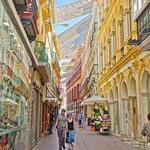Things To Do
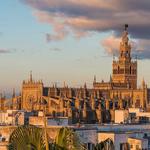
Catedral de Sevilla
The Cathedral of Seville is world’s largest Gothic cathedral. It was built between 1434 and 1517 over the remains of what had previously been the city’s main mosque. Inside, the cathedral is impressive both for its artworks in the form of paintings, sculptures, and woodcarvings, and for its architectural mix of Gothic, Renaissance, Baroque, and Plateresque styles. Because Christopher Columbus departed for the New World from Sevilla, the cathedral contains a 19th-century tomb housing the remains of this famous explorer. The wedding ceremony will be held in the Cathedral's parish church, the Parroquia del Sagrario.
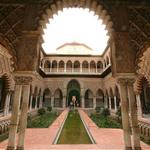
Royal Alcázar of Sevilla
Declared a World Heritage Site by Unesco, the Royal Alcazar of Seville is Europe’s oldest palace in use. Its origins go back to the 11th century, when Muslim authorities decided to build a fortress in a strategic area of Seville in order to guarantee its security. Protected by a wall, the Alcazar site is made up of diverse palaces and gardens designed during different historical periods. The Alcazar of Seville offers a wide range of styles, combining elements typical of Muslim, Gothic, Renaissance, Baroque and Romantic art, as well as some of the best examples of Mudejar art, product of the mix of Islamic and Christian culture. We recommend you buy your tickets early! You'll also need to bring your passport for verification upon entry.
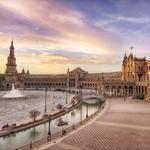
Plaza de España
The Plaza de España is the most famous public space in Seville. Several buildings were designed for the Ibero-American exhibition of 1929 in and around the Maria-Luisa Park. Aníbal González designed this Spanish square, which is in Spanish Renaissance style with a diameter of 200 metres. Spain's goal with the exhibition was to make symbolic peace with its former American colonies. Fun fact: The Plaza de España has been used as a filming location, including scenes for Lawrence of Arabia (1962). The building was used as a location in the Star Wars movie series Star Wars: Episode II – Attack of the Clones (2002) — in which it featured in exterior shots of the City of Theed on the Planet Naboo.
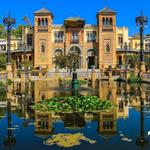
Parque de María Luisa
The Maria Luisa Park is formed in part by the gardens of the San Telmo Palace, donated in 1893 to the town of Seville by the Infanta Maria Luisa (Duchess of Montpensier) which were incorporated into the urban heritage in 1911. In 1893 the Queen's Sewing Box and a metal structure greenhouse were built. In 1910, the park was chosen as the main location for the future Spanish-American Exhibition that would take place in 1929. Today, Maria Luisa Park is a paradisical half-mile of palms and orange trees, elms and Mediterranean pines, covered with flower beds and dotted with hidden bowers, tiled benches, ponds, fountains and pavilions. Large enough never to feel crowded, the park is a delightful place for a quiet stroll, a kids' runabout, or romantic horse-and-carriage or boat ride. Taking a horse and carriage is a great way to see the shady avenues of the park; a more energetic option is a bike for four with sunshade.
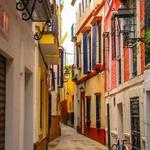
Barrio Santa Cruz, Sevilla
The Barrio Santa Cruz is home to Seville Cathedral, a Gothic landmark offering views from the Giralda bell tower, and the Real Alcázar, a Moorish-Renaissance palace backed by lush gardens. Tapas bars on nearby Calle Mateos Gago serve octopus and Iberian ham, while the old Jewish quarter’s narrow streets and orange tree–lined squares are dotted with shops selling souvenirs, handicrafts and ceramics.
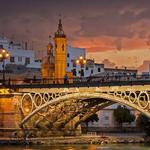
Puente de Triana
The Puente de Isabel II, Puente de Triana or Triana Bridge, is a metal arch bridge in Seville, Spain, that connects the Triana neighbourhood with the centre of the city. It crosses the Canal de Alfonso XIII, one of the arms of the River Guadalquivir that isolate Triana as an almost-island. It was built during the reign of Isabella II of Spain and completed in 1852 as the first solid bridge in Seville, replacing an earlier floating bridge consisting of boats (a pontoon bridge). First built by the Moors in the 12th century, the pontoon bridge managed to exist for seven centuries due to later repairs. The Puente de Triana is a wonderful spot to enjoy the sun setting on the Sevilla city skyline.
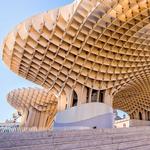
Setas de Sevilla
Setas de Sevilla ("Mushrooms of Seville") or Las Setas ("The Mushrooms"), initially titled Metropol Parasol, is a large, predominantly wood structure located at La Encarnación square in the old quarter of Seville, Spain. It accommodates a traditional market, restaurants, a performance square, archaeological museum — and 'rooftop' terrace with a panoramic view of Seville's old city.

Sevilla Museum of Fine Arts
The Museo de Bellas Artes de Sevilla is the most important Museum of Fine Arts of Seville and Andalusia. After the Prado Museum in Madrid, this is perhaps the most important art museum in Spain. In the museum, you will find works of art from the Middle Ages, Renaissance, Baroque era and up to the 20th century, mainly Spanish artists such as Francisco da Herrera, Murillo, El Greco, Velásquez, José García Ramos and Francisco Zurbarán, but also from foreign painters such as Jan Brueghel l'Ancien, Pieter Aertsen and Cornelis de Vos.
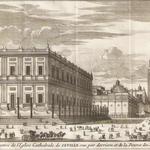
Grabados Y Mapas Antiguos Laurence Shand
The owner of this prints and maps store is Laurence Shand, a specialist in selling original antique maps and prints ranging from the XVI century to the XIX century. His store always has an impressive stock of prints of Seville, Cadiz, Granada and Cordoba as well as good selection of Antique maps of Spain from the last 400 years. The store also sells old maps of Spanish regions from the XVII century. Here you can also find a stock of antique maps of other parts of the world, botanical prints, architecture, equestrian, natural history, mythology, portraits and religious subjects. A great place to buy a unique souvenir! Laurence carefully packages all prints and maps to ensure safe travel back home. A great stop after the Museum of Fine Arts (right next door).
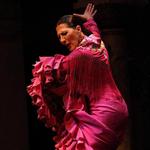
Flamenco Dance Museum
Seville's Museum of Flamenco Dance is the first and only museum of its type in the world - a modern museum preserving ancient roots. It is in a beautiful 18th century building, built on the foundations of an old Roman temple. At the highest point of the city, it has a vaulted cellar and a courtyard in the Ecija-style that is unique in Seville. The museum walls were built on an urn containing copies of the Bible, the Koran, the Talmud and Hindu writings, as symbols of peace and understanding. The unique architecture and spirit of the building engulf visitors when they enter the Museum. The Museum of Flamenco Dance is an excellent gateway to the magical world of flamenco. It offers a unique experience, where the diverse facets of this art - dance, song and guitar - come together. A great place to view an authentic Flamenco show!
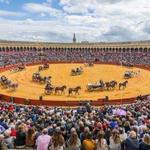
Plaza de Toros de la Real Maestranza de Caballería de Sevilla
The Plaza de Toros de Sevilla is the largest and most important arena for bullfighting in Spain. For example, the largest bullfighting festival in the world is held during the festival week Feria de Abril. The full name is "La Plaza de Toros de la Real Maestranza de Caballería de Sevilla." The oval arena is located in the El Arenal harbour district, was built in the 18th century and can accommodate 13,000 spectators. The Plaza de Toros has a unique Baroque façade, dating from 1762-1881.
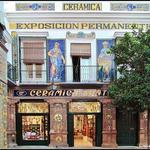
Ceramica Triana
Andalucía is famous for its long history of ceramic creation, and no Andalusian courtyard or house is complete with its own special collection of colorful tiles. The Centro Cerámica Triana is housed in the former Fábrica de Cerámica Santa Ana Rodríguez Díaz (Ceramics Factory of Santa Ana Rodríguez Díaz), where the design, production, exhibition, and sale of ceramics took place for a long time. From outside, it’s difficult to guess what is hidden behind the historical façades of Triana, the old artisans’ district of Seville. However, Triana used to be home to Seville’s famous tile workshops and potteries. Almost any tile you see in the city’s churches, hotels, bars and private houses, as well as the gorgeous Plaza de España, will have been made here in Triana. The industry dates back to Roman times, using clay from La Cartuja, to the north of the area. This is a great place to buy tiles and take a piece of Sevilla home with you! Rocio Triana Ceramica is another favorite.
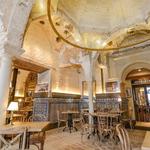
Cervecería Giralda Bar
In February of 2021, renovations of this famous Seville tapas bar uncovered the remains a 12th century Islamic bathhouse with uniquely rich decorations. The Cervecería Giralda in the historic center of Seville has been one of the city’s most popular bars since it opened in 1923. The building has soaring vaulted ceilings supported by four columns, typical of the medieval bathhouses or hammams. It’s the best preserved Almohad hammam in the Iberian Peninsula and an incredible spot to enjoy authentic and traditional Andalusian cuisine.
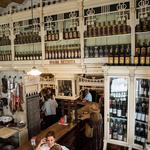
El Rinconcillo
El Rinconcillo, founded in 1670, holds the title of the most ancient bar of Seville. In 1858, the De Rueda family (the current owners of this magical place) acquired the property located at n.40 of Gerona Street, which originally was an old tavern. One of the biggest treasures of El Rinconcillo is its ancestral ornamentation that has been preserved for more than 300 years and still attracts visitors from all over the world. On the ground floor, one can enjoy flavorful tapas and gratifying wines on its mahogany bar as well as at the typical Andalusian barrel-tables, or also eat on one of its marble-made tables while sitting on bulrush-made wooden chairs. In addition to this, its full of old bottles, carved shelves, its patio, its typical stone slabs combined with cement tiles, its typical Arabic brick walls, the patterns of the ceramic tiles of the walls from the 17th, 18th and 19th centuries will take visitors to another epoch.

Casa Moreno
Casa Moreno, the oldest existing ultramarino, or grocery store, in Sevilla is still serving it’s original purpose, and then some. Apart from stocking a bounty of quality canned and bulk foods, cheeses and charcuterie, Casa Moreno contains a hidden bar that most tourist never come across. Upon entering the store, you find yourself surrounded by latas stacked with precision. There is no real kitchen at Casa Moreno, so the food is inherently simple. This is a place where you come to understand the simple pleasures of a media mañana (late morning snack) consisting of a montadito (small sandwich) with a tercio (33 cl beer).
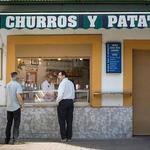
Churros Y Patatas
Churros are a dough based on wheat flour cooked in oil and is sometimes called a "fruit of the frying pan." Its origin dates back to the days of Al-Andalus although during the Christian Reconquista of the Arabs, they were adopted into their Catholic culture. Churros y Patatas is one of the best spots in the city to enjoy some churros con chocolate! Just make sure to check their hours before planning your visit.
